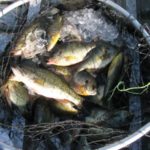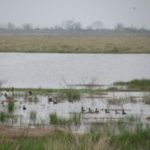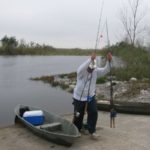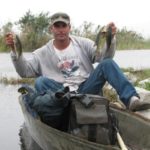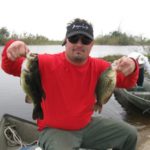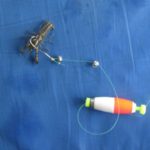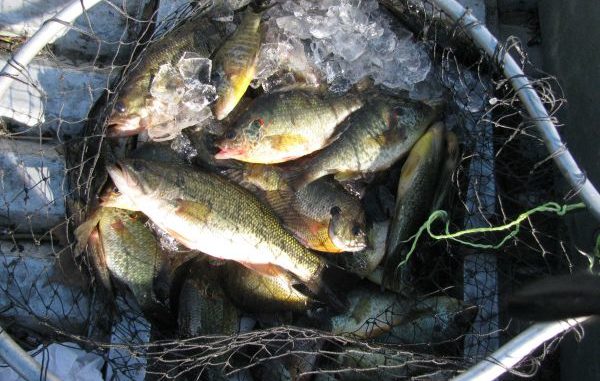
Sometimes returning to old stomping grounds — and old fishing tactics — can be just the ticket to liven up your day. Bayou Sauvage National Wildlife Refuge’s panfishing is the perfect example.
Artie blew up at the very mention of the place.
“Man don’t even say the word!” he snarled. “Brings back too many memories! Now it’s all gone!”
Actually, all the memories were sweet.
“Man, the best ducks around! And the easiest!” Artie continued, mellowing after another bite from a scrumptious 4-point fajita and another gulp from one of Trisha’s famous margaritas. “Trow a ’rogue in backa your truck. Hang a left at Powers Junction on the Chef Highway onto Highway 11. Pull over on the shoulder off Highway 11 and slip the ’rogue in the waaaw-da! Paddle out a little bit, trow out a few dekes — and start blasting ducks. And I mean GOOD ducks. I mean huge flocks of teal and greys! And French ducks, mammy!”
“And poule d’eau out the wazooo!” added Pelayo. “Remember the rafts of poule d’eau? Man, how many you want? Just paddle up to a flock and start blasting! The poule d’eau back there was thicker than rice birds in a flooded pasture. Remember the pots of gumbo and jambalaya we’d make with ’em for da games? Gizzards and all!
“Man, we was tailgaters WAY before tailgating was cool! Doze was DA DAYZ!”
Nobody argued with Artie. We all recalled it just as fondly. But it was hardly “all gone.” Maybe the duck hunting (except regulated youth hunts), but the “perch-jerking” and panfishing for marsh bass, lake runners, catfish, sac-a-lait remains as good as ever in this area known since 1990 as the Bayou Sauvage National Wildlife Refuge.
When we duck hunted this gorgeous stretch of mostly fresh marsh, it was known variously as “New Orleans East” or “Orlandia,” in honor of the massive mini-metropolis to come. Those two unused exits on 1-10 between Michoud Boulevard and Irish Bayou east of New Orleans were originally built to access the forthcoming network of ritzy subdivisions.
Then the development plans went kaput. You don’t often associate subdivision preparations with preserving pristine wetlands, but here’s a baffling exception, a shining example of “the law of unintended consequences.”
To wit: Lakes Pontchartrain, Borgne and St. Catherine border the sprawling wetlands planned for draining and development as Orlandia. So levees were built to surround the area on all sides as protection from Hurricane surges. And that’s exactly what they’re still doing, after almost 40 years. But they don’t protect any homes — instead they protect a pristine freshwater marsh from the same saltwater surges.
Katrina topped the levees and clobbered it, but Isaac did minimal damage. The levees were high enough and held. So the tsunami that went up through Lakes Borgne and Pontchartrain all the way to Sorrento this past August and caused (freshwater) fish kills everyplace from The Pearl though Bayou Lacombe to the Tchfuncte, Tangipahoa,Tickfaw and Blind rivers pretty much spared the fish in the Bayou Sauvage NWR.
Only outboards of 25 horses and under are allowed in the levee-enclosed portions of the refugee. So it’s a veritable paradise for piroguers! And, oh, OK, also for kayakers and canoeists. (There. I actually uttered the terms. WOO! Glad that’s over. Many of these latter frequent the place, anyway. The bumper stickers in the parking lot with peace signs, rainbows and “Coexist,” are a dead giveaway.)
Bank fishing is also popular and fruitful along old Highway 11 in the refuge. In fact, these bankfishermen — like any piroguers and kayakers who launch away from the main ramp — are fishing waters totally untapped by motorboaters. And there sure aren’t many other places around New Orleans where such fishing is possible nowadays.
The 4-point fajitas and the sheepshead ceviche were about gone when the plans started to gel. Pirogues would be the craft, perch-jerking — in our lexicon, this refers to light-tackle fishing for any panfish from “perch” (bluegills) to “Lake runners” (redeared sunfish) to marsh bass to channel cats to goggle-eye — would be the function, and our old duck-hunting stomping grounds off Highway 11 would be the setting.
And, oh! Duck calls would also feature in the outing. Please hear us out.
In April, this place is loaded with ducks, mostly teal and spoonies returning from wintering spots farther south. For any duck hunter (much less fanatical ones), just watching them fly around and circle and land, circle and land, etc. makes a trip to the area more than worthwhile — downright enchanting, in fact. Tooting on our calls to coax them closer, to behold the magnificence of the sight — between jerking aboard the makings of a serious fish fry at Doc’s — sounded like JUST DA TICKET!
We unloaded the ’rogues on the main ramp on Highway 11 just south of Irish Bayou, grabbed and signed our refuge passes from the little shed and shoved off. In minutes, we were paddling down (west actually) the main canal. Then we hung a left at the main canal intersection and started working the grassy banks on our way southwest.
Eddie was chunking a small, silver crankbait to mimic the shad in the area, while I grabbed my ultralight spinning outfit, stuck on a cambarellus shufeldtii and prepared to cast ….
“WHAT?!” some grumble. “Some fancy new lure’s come out and nobody told us about it! And here you guys even have a ‘Lure Review’ and a ‘New Products’ department?”
Calm down, amigos. It’s not a lure, and there’s nothing new about this bait. It’s a live crawfish, and it’s been around for years at your friendly neighborhood roadside ditch. We think of crawfish as those big, red, juicy ones whose heads we slurp between beer gulps while BSing at boils about our latest catch, latest kills and college-age conquests in amour.
But there’s actually 540 species of crawfish worldwide. Another name for the hapless little creature I impaled on my skinny No. 4 perch hook is the Cajun dwarf crawfish. These are the ones that live in the shallow roadside (especially in the I-12 side ditches) and can be scooped up by the bucketful in spring, especially after rains. They don’t grow much over an inch long, so they make ideal bait for just about every panfish we were seeking. Lake-runners — given their fondness for little crustaceans, hence their alias, “Shellcrackers” — are especially fond of this crunchy fare.
At any rate, I impaled him on the hook 3 feet under a little bobber and about a foot under a couple of split shots, and cast toward the very edge of the alligator grass. Just as my cork bounced in the waaaw-da, Pelayo’s plopped about 3 feet away. Pelayo looked over, grinning. He also knew what a panfish hole looked like.
In fact, we both recalled the time-tested lake-runner fishing advice from the late and legendary Jimmie Dixon of Chalmette’s Bait Inc.
“One thing you gotta remember about lake runners, Hom-Boy-Da,” he told us. “They love weeds and grass. I’ve caught them at all depths, but it’s always around grass. Often, I won’t just cast next to the grass. If the spot looks good enough, I’ll actually move in and clear out holes in grass beds with my paddle or a net. Grass shrimp is the best bait, period.”
“I even chum with them. When I get to a spot that looks lake runner, say a deep hole in a dead-end canal or a bend in a marsh bayou that the current’s dug deep, I’ll crush a handful of grass shrimp and throw ’em out. In a few minutes you see the swirls in the waaaw-da and know the feeding frenzy’s starting. Then I drop in my bait with my jigging pole — ya follw me, Hom-Boy-Da?”
I followed Jimmy’s advice but with a close enough facsimile — those dwarf crawfish. Though no feeding frenzy seemed evident — Pelayo’s cork soon plunged.
“That’s him!” he whooped. “Can’t beat grass shrimp!”
In fact, a few grass shrimp had come up in the scoop net along with the little crawfish. One of them had lasted all about 15 seconds in the waaaw-da before getting inhaled. The look on Pelayo’s face as the little pole bent and the 6-pound-test screeched off the reel was the look of a man rediscovering a childhood diversion.
“Man, these little suckers put up a heck of a fight for their size!” he beamed.
It was the classic scrap of chunky lake runner: frenzied runs from side to side, even a little surface action.
Pelayo plucked him from the dark water and held him in the mornings first rays. He was a beauty — for us. Maybe 8 inches long. Chunkier than a bluegill, flecked in brilliant green with a lone red spot behind the gills. From this comes his technical name: red-eared sunfish. But call them that around New Orleans and you’ll get blank looks or scoffs. In fact, call them that almost anywhere outside of a convention of freshwater biologists and you’re likely to get the same response.
This fish is a “chinquapin” to Cajuns, a “shellcracker” to rednecks and a “lake runner” to Bogalees and Yats. I guess that takes care of everyone who fishes for them.
I looked over at Eddie on the opposite bank, and he was pointing. Ah, yes! A flock of blue-winged teal cartwheeling over the marsh to our left. I let fly with a short, sharp hail, and they beelined for us. Gorgeous!
Then I noticed two mottled ducks overhead. I let fly with another hail, and they quickly locked up.
“Man!” Pelayo laughed while his lake runner flopped in the bucket. “They sure don’t act this way during da season!”
Then I felt a pull — where’s my cork? — where?
“Dat’s him!” And my classic little Mitchell 308 started the sweet music while surrendering line. Soon a scrappy bluegill was also flopping in the bucket. My dwarf crawfish hadn’t lasted much longer than Pelayo’s grass shrimp.
“Another one here!” yelled Eddie from across the canal. Pelayo and I turned in time to see his little bass leap and cartwheel twice, and then go into a frenzy of lunges and surface thrashing until Eddie hoisted him aboard triumphantly. “Told you these little crankbaits were the ticket for bass around here!”
We caught another bluegill and a fat goggle-eye, and then resumed the paddle until we came to a smaller intersection. Here a little winding slough that shows up in old maps as Bayou Castiglioni met the main canal. The place had panfish written all over it, especially now that the tide was starting to drop, because a nice little rip had formed at the mouth of the little cut. Not a color change, mind you. Back here ALL the water’s pretty much the classic root-beer dark. But a little current line was evident.
Offshore, this element attracts tuna, wahoo, tripletail and dolphin; a little farther in, it attracts cobia and kings. Much farther in, they attract specks and reds. And here in fresh marsh, they usually concentrate panfish.
In fact, my first cast landed in the grass and I didn’t even have time to pop the little cork. WHAM! The bobber plunged, another dwarf crawfish bit the dust and the battle was joined.
Now what kind of lunatic would describe the process of reeling in a half-pound fish on 6-pound-test line as a “battle?”
A fanatical panfishermen, that’s who. But, in fact, it was a bit more than a half pound — more like pound and a half, and a channel cat to boot. The fillets would fry up gorgeously.
“Another one here!” yelled Pelayo, and I turned in time to see him battling it out with another chunky bluegill, as Eddie whooped crazily. He was on another marsh bass. “Told you these little spinnerbaits were the ticket!” He’d switched from his crankbait for a blue spinnerbait for the occasion.
Soon we hit upon the idea of half-pushing, half carrying our ’rogues into this Bayou Castiglioni itself, reasoning that here was truly virgin territory. No way even a small skiff with a trolling motor could get in here.
“Oh brother,” laughed Pelayo, pointing at me. “Here we go: Mr. Retro fisherman strutting his stuff.”
He was referring to my new choice of baits: little tandem shad rigs sweetened with maaw-ket shrimp under a cork.
“A Mitchell 308 and shad rigs!” I beamed while waving my rig and jig around. “So who’s passing to Danny Abramowics? Gary Cuazo or Bill Kilmer?”
Usually we use shrimp-tipped mini-jigs. Those little tandem shad rigs struck me as basically the same thing, with the memory-lane bonus. My little bobber hit near the rip, bobbed twice, twirled in the current and vanished as it neared the edge of the alligator grass.
Another pretty channel cat soon validated my choice of retro-bait.
“Hey, hey!” Pelayo yelled while setting the hook. Then his fish started tugging and lunging, and finally thrashing the surface. In minutes Pelayo swung aboard another nice bluegill as Eddie held up a lake runner.
My next cast nailed a little yellow bass within seconds of hitting the water. Pelayo was on another bluegill in short order. Then his drag started singing — “Oh, oh!” he frowned. “Looks and sounds — like a choupique!”
Instead, he was soon swinging aboard another perfect-sized channel cat. And so it went until we closed down with a mixed box (buckets actually) of 23 panfish. We figured four po-boys would result, dressed with homemade tartar sauce and Creole tomatoes! Yeah-you-rite!
